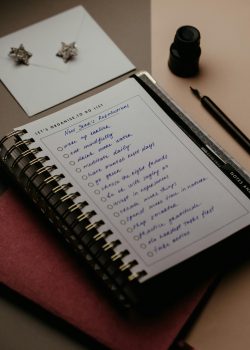Check out our tips in The Spruce

When it comes to home organizing, there are a lot of common misconceptions floating around. We spoke with pro organizers and asked them to debunk some of the main myths that we often hear when it comes to decluttering, and you may be surprised at what they share below.
Janet Bernstein, a professional organizer and founder of The Organizing Professionals, notes that many times, clients are fearful of parting ways with their items during the decluttering process. In reality, though, it’s extremely rare that giving an item away causes any feelings of regret.
Click Here to Find the Motivation You Need to Get Organized in 2024!

Dieting, working out, and getting more organized continually top the list of New Year’s resolutions. All three, however, typically fall by the wayside by February. I have no hard science behind this, but my theory is these three tend to be the hardest to consistently maintain. There’s no shortage of advice out there but have you ever considered finding the motivation that successfully works for you? Let’s look at four of my favorite methods:
Treats (not just for pets) – Motivating yourself by using the treat method works well for many people and there are endless ways to implement this. For example, you want to organize your desk but keep avoiding it. Consider setting a 30-minute timer with the goal of a tea-time break (or glass of wine) when you finish the project. The rewards can increase in scale depending on the size and scope of your project. Maybe you’ve been putting off a mammoth project that will have significant benefits if you could only complete it. Rewarding yourself with a vacation could be a significant motivator. As the new year approaches, consider what rewards motivate you, then draw up a short list of projects you want to accomplish next year and the intended reward that will be yours after completion.
Body Doubling (not just for actors) – Body doubling works well for those who become more productive when surrounded by one or several others. A professional organizer colleague once told me she worked with an author client who hired the organizer to sit in her office while she wrote. You may think that’s crazy, but I counter the client had identified what she needed to keep her motivated. As professional organizers, we often function as body doubles, maybe not just sitting in a chair, but working alongside our clients helping them declutter, or implement organizing systems in their homes. “If you weren’t here, I’d never do this” is a refrain we frequently hear from our clients. A body double doesn’t have to be a professional organizer, it can also be a patient, non-judgmental friend or relative.
Accountability – Finding an accountability partner is a great way to stay on track with your organizing goals. This method works for those who function well independently, yet need a little extra push to ensure they complete their tasks. An accountability partner can be a coach, professional organizer, colleague, or friend—someone with whom you have communicated your goals and who will check in with you to make sure you are on track.
Scheduling – This simply means allocating time on your calendar for your projects. Instead of arbitrarily planning to do a task, you schedule it in your calendar as if it were an appointment. It gives a framework and a deadline to keep you on track. I use the scheduling method for practically everything on my to-do list. Between using the treat method and scheduling, I find I’m able to complete most of my projects on time.
Which of these methods resonates with you or do you use another method? I’d love to hear. Meanwhile, now that I’ve completed writing this article, I have a cup of tea and a biscuit waiting for me!
Wishing you a very happy and productive New Year!
Janet
Why You Absolutely, Emphatically Need a Home Inventory

In December 2021, I took my daughters on a belated, celebratory college graduation trip to Maui. It was the trip of a lifetime. We experienced our first Luau on Lahaina beach, took a sunset cruise from the harbor, and on other evenings ate at one of the many lovely restaurants along Front Street close to the ancient Banyan tree. The recent wildfire and almost complete destruction of that lovely town affected me on a deep level. Having been there personally, it’s hard to imagine that the town and so many lives are now lost.
While wildfires may not be a threat to those of us living in the northeast United States, we are not immune to other disasters. And yet most of us are not prepared for an emergency, whether it means leaving our home in a hurry (check out this link to be prepared with a ‘Go Bag’) or having the necessary documentation to file a claim should calamity happen to our home.
I have recently been working with a client creating a digital home inventory using Home Zada. Using the app version, we have been working our way through her home, taking both photos and videos of each room. Using the desktop version, we then add notes, descriptions, or supporting documents such as receipts for furniture, art, and appliances. We even add the make and color of paint in various rooms. With the paid version, there is also a place to add home maintenance records and renovation projects. My client’s goal, however, is to create a cloud-based record of all the items in her home in case of a worst-case scenario.
The process has been easy and enjoyable, and my client now has the peace of mind that she has all her ducks in a row should disaster strike. I just started working on my own account and I’m looking forward to feeling a great sense of accomplishment when it’s complete. For most of us, these are the tasks we put off for a rainy day. Like digitizing photos and personal memorabilia, we convince ourselves we’ll get around to it later. Would anyone, however, dispute that these items are the most important in a disaster? We frequently witness scenes on television of people scouring the ruins of their homes for family photos and precious documents. All other items can be replaced.
If you have been postponing the task of creating your own home inventory and live in the greater Philadelphia area, give us a call. We can collaborate or even create the inventory for you. If you would like to create your own inventory, here’s the link to Home Zada*. https://www.homezada.com/?afmc=ka
Did you know we also offer complete photo organizing and memorabilia digitizing services? Contact us at info@TheOrganizingProfessionals.com and let’s get that mental ‘to do’ item crossed off your list!
*We may receive a very small affiliate commission should you select one of the paid versions of Home Zada
My Foolproof Strategy for Decluttering With Kids (Even Adult Kids)

We are currently undergoing renovation of our primary bedroom and bathroom. This required us to move everything from our bedroom into one of our daughters’ bedrooms. This particular daughter now in her mid-twenties, conveniently left home earlier this year. Adult kids, however, rarely take 100% of their worldly possessions with them.
Said daughter’s room looked exactly like she still lived at home. Her closet burst with clothing, knick knacks strewn around, diplomas on the wall; I think even the TV was still plugged in. How were we going to get her to empty out her room?
Fortunately, I had one trump card to play—my birthday—which was a couple of weeks away. Most young people, I’ve observed, seem to have more free time than cash. An idea hit me that, honestly, I wish I’d thought of years ago. I told my daughter the only thing I wanted for my birthday was the gift of her time and together we would declutter her room.
I can’t say I received an enthusiastic response but to her credit, she came over, and together, in an afternoon, we decluttered her entire bedroom and bathroom. Now, you may rightfully be wondering how we accomplished such a mammoth task in the space of a few short hours. It probably doesn’t hurt that her mom is a professional organizer so here are a few pro tips if you decide to use this strategy yourself:
- An excellent poker face. Let your child make the decisions of what to keep and what to let go. If you chime in with your opinion on each item, you will dramatically increase the time needed, not to mention the tension in the room.
- Come prepared. You will need:
- 30-gallon clear trash bags for donations
- 30-gallon black trash bags for trash
- Several small previously used boxes for books and fragile donations
- Storage tubs (but hopefully not too many!) for memorabilia. These from Target are my favorite Target Storage Tub but these are even better for long term storage The Container Store Weathertight Tub
- Adhesive labels and a permanent marker to label the tubs (make sure you label the top and two sides for easy identification.
- Although, this is their gift to you, I recommend only scheduling a certain amount of time. Perhaps just an hour with a very young child and a maximum of four hours with adult kids. If their room is extremely cluttered, you may need to use ‘the gift of time’ strategy for several birthdays, and also include Mother’s Day and Christmas!
- Consider scheduling short FaceTime sessions if your adult child no longer lives in the area. Simply reverse the phone screen and tackle one small area at a time.
Let us know how this strategy works for you,
Best of luck!
Janet
Check out our tips featured in Homes and Gardens

Moving in with a partner for the first time can be a wonderful experience – until you have to find a place for both of your things all under one roof.
No matter how meticulous your house moving checklist is, you are bound to end up with duplicates, home decor that doesn’t exactly match one another’s style, and clutter that drives one or other of you up the wall at some point. So how do you organize and declutter when moving in with a partner?
Luckily, professional home organizers have the solutions.